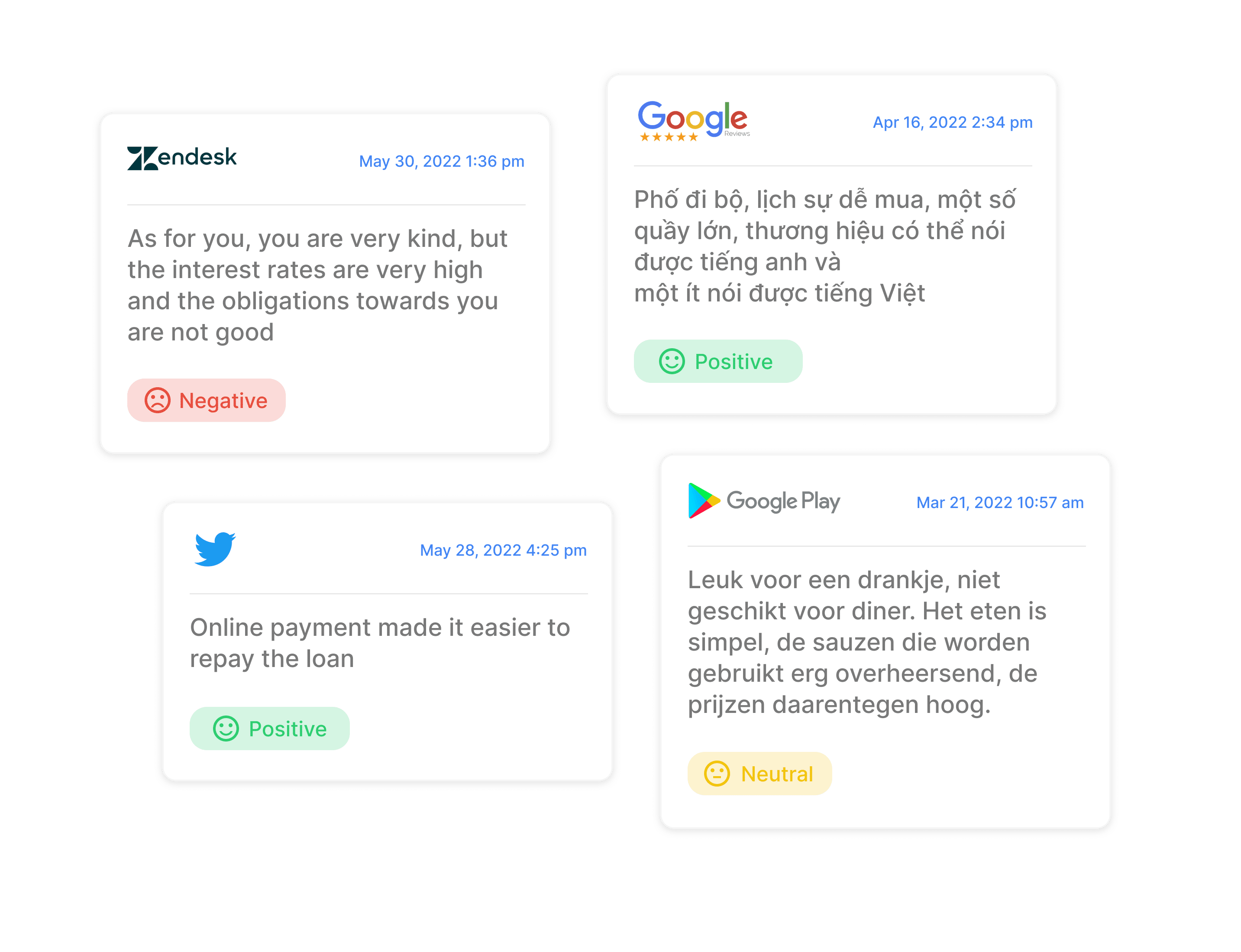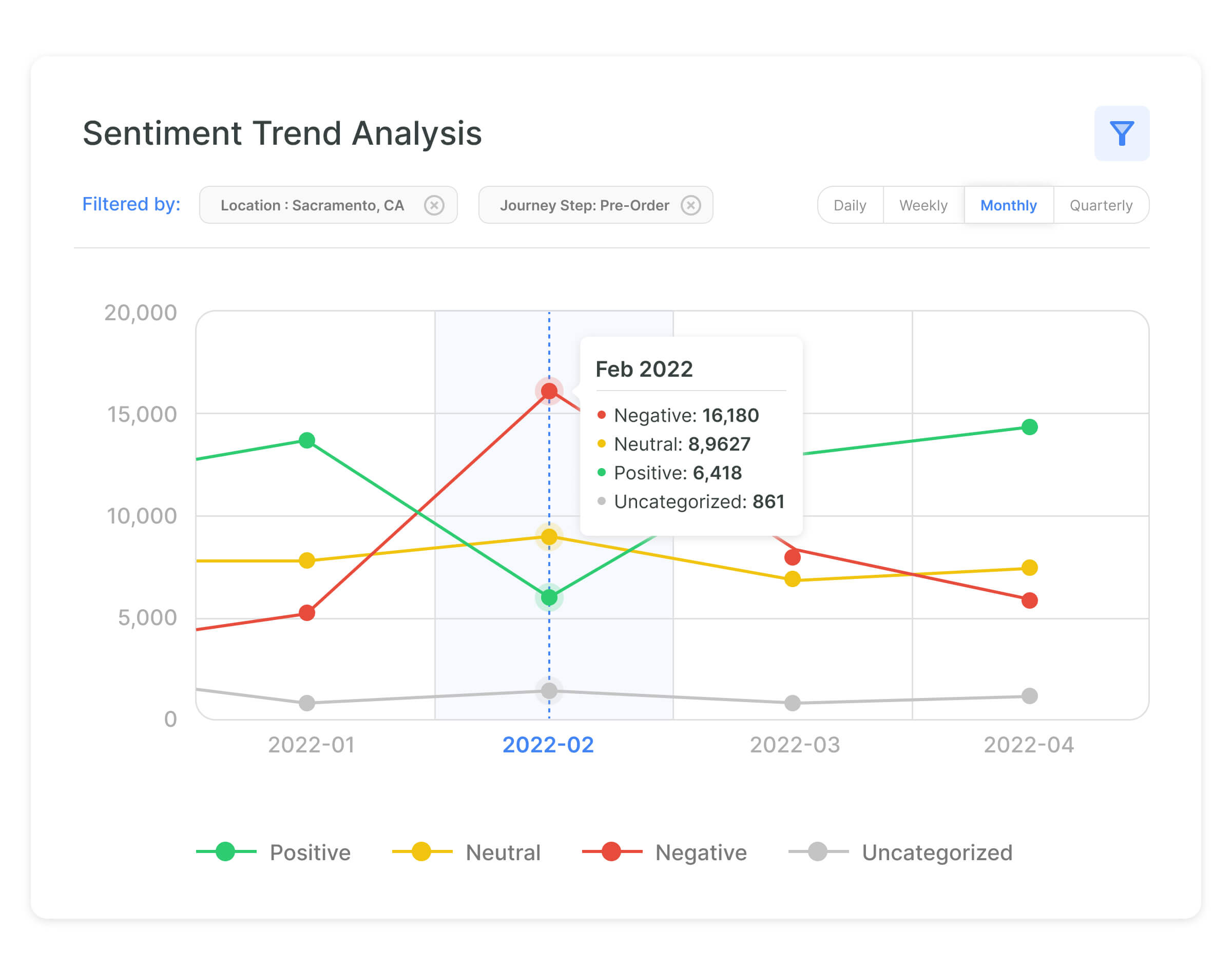Sentiment Analysis Tool
- AI-driven real-time recognition of customer sentiments
- Able to capture context-dependent sentiments
- Able to detect sarcasm, idioms, or ironies
- Sentiment analysis fueled by Natural Language Processing

Trusted By World's Leading Customer-Centric Brands
What is sentiment analysis?
What are sentiment analysis examples?
How does AI-driven CX management boost sentiment analysis?
How is sentiment analysis useful?
How do we help?
How does Alterna CX’s sentiment analysis work?
What is sentiment analysis?
It is an application utilizing machine learning and natural language processing (NLP) techniques. Its function automatically detects and classifies sentiments within basically a range of three different polarities: Positive, Negative, Neutral. Using a sentiment analysis definition, we may consider this an authoritative tool that allows us to understand the public mood. Businesses are starting to take notice, and many companies are now using it to track how their customers feel about them, then adjust their customer experience efforts. Sentiment analysis enhanced with an accurate and precise NLP model can be deployed for various objectives ranging from understanding customer feedback on social media to detecting sarcasm in online comments, from comprehending common sense to automatically detecting customer satisfaction or dissatisfaction.
Besides, emotion analysis uses much more complex machine learning algorithms for detecting distinct human emotion types such as joy, trust, fear, surprise, sadness, anger, and disgust. It is a more highly evolved model of sentimental analysis.
What are sentiment analysis examples?
Here are some real-world examples across industries and geographies where Alterna CX’s AI-driven CX software recognizes, with the help of an accurate sentiment analysis algorithm, sentence polarity.

How does AI-driven CX management boost sentiment analysis?
AI-driven CX management software provides a holistic view about customers’ real feelings and thoughts. A superbly conceived machine learning technique provides momentum to customer sentiment analysis. Real-time, accurate, and simultaneous cross analysis of respondents’ sentiments, emotions, and pain points lets CX professionals get actionable insights and understand root causes of dissatisfaction. On the other hand, for example, output of a social media sentiment analysis that fails to leverage text analytics is often siloed and disconnected from other pertinent customer experience signals.
How is sentiment analysis useful?
Here are three ways to use Alterna CX’s sentiment analyzer for increasing customer experience quality:
- Product roadmap planning
Various types of sentiment analysis can use unstructured data to help you learn how people felt about your latest product launch. This data could tell you that people love the product’s appearance but find it difficult to use. Customer sentiment analysis contemplates, over time, what these complaints about “ease of use” are all about. It informs your enterprise about the aspects and themes in each response, allowing you to answer questions like: “For how long do people react negatively to a product price increase?” Or, “Are they really content about the new feature added?”
- Fine tuning a pricing strategy
It facilitates pricing strategy in real time. For example, in today’s digital retail environment, key value categories (KVCs) and key value items (KVIs) are integral to pricing strategy. Sentiment analysis tools can be used to analyze negative comments that indicate issues and trends with respect to KVI products’ “price”. This dynamic approach lets retailers refresh their lists and finetune the execution of pricing strategy in real time. Flexing KVC and KVI lists by price zone or geography, rather than remaining content with static corporate KVC and KVI lists, provides retailers a competitive edge by allowing them to take sentiments into consideration while determining prices.
- Turning sentiments into actions
The best way to leverage sentiment scoring is to customize your alert rules based on various “human” signals such as emotional text or social media comments, whether they be positive, negative, or neutral. Desired customer sentiment analysis results can be filtered from social media comments or survey answers. Multiple results can also be selected.

How do we help?
Alterna CX’s sentiment analyzer automatically classifies the tone of a text so as to achieve high accuracy for identifying the root causes of that sort of comment. This automated efficiency removes the need for human effort and creates a single source for all customer experience feedback. Alterna CX’s sentiment model works with a strong machine learning algorithm to automatically identify and categorize polarity.
The model ensures that customer experience professionals can see comments, then use that informative feedback as a basis for appropriate action. Moreover, along with open-end text responses and general satisfaction driver criteria, the model is used for the creation of its own predictive analytics model. It has been trained by multiple source data from complaints and review sites such as Amazon.com and Trustpilot.com. We update all of our models continuously with best practices. What is more, a new sentiment model with a new annotation set can be created and updated with new data sets.
There are a few different ways to approach this type of analysis, but they can all essentially be reduced to two categories: positive or negative. Alterna CX’s current sentiment model has three categories: Positive, Negative, Neutral.
How does Alterna CX’s sentiment analysis work?
Machine learning, statistics, and natural language processing (NLP) are some of the tools that Alterna CX’s sentiment model uses to identify customers’ feelings and thoughts in the broadest sense possible.
What is more, unlike general sentence-based sentiment analysis systems, the Alterna CX’s Tool is able to apply sentiment to each topic. The tool processes written content in order to discover whether the expression is positive or negative.
This process is done in two ways; although the best results come from combining the two methods.
- What is rule-based sentiment analysis?
In this method, a score is given for each word to scale the sentiment in the format of a word-list or a lexicon. For example:
“super” = 0.9; “old-fashioned” = -0.7; “ok” = 0.1
By using these kinds of weightings, sentences are respectively resolved for overall positivity or negativity.
Sarcasm, idioms or other verbal deviations generally require additional finesse in rule-based systems.
- What is sentiment analysis in machine learning?
Another approach is to use human-labeled data. The use of human-labeled data for sentimental analysis is a valuable technique that can be used to identify positive and negative sentiments. The technique relies on the use of machine learning algorithms to screen the text for positive or negative words and expressions. This technique can be used to improve the accuracy of algorithms and can also be applied to improve the accuracy of mechanical predictions. Once trained, it may also be considered for use on new data sets.
Get a Personalized Demo with Your Data!
Join category‑leading companies and start driving growth, reducing churn, and building loyalty with Alterna's AI technology!
Gain insights into your company's oCX score and compare it with those of your competitors.
Discover the specific areas where your company struggles and uncover opportunities for growth.
Use insights to strengthen your brand's reputation and increase positive customer sentiment.
See Alterna CX In Action
By submitting, you agree to Alterna's privacy policy and agree to receive emails from Alterna CX. You can opt out anytime.










